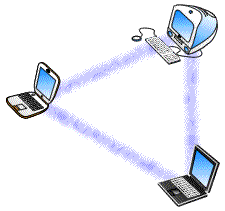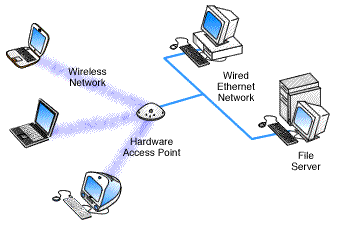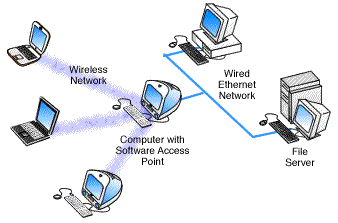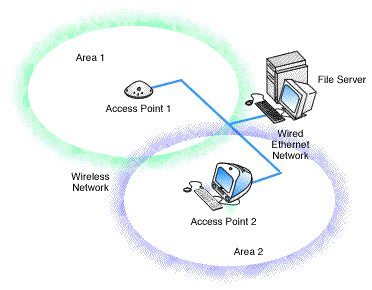----------------------------------------------------
GENERAL FAQ
What is a wireless network?
Recent advances in computer networks have enabled computers to communicate on a wireless network. The technology is known as 802.11b or as WiFi (Wireless Fidelity).
802.11b technology is also being used to distribute the internet to computers in public spaces such as airports, coffee shops and other locations where the public desires to have an internet connection. These public networks are commonly referred to as a "Hot Spots". You can learn more about 802.11b technology and their use in Hot Spots at
Wi-Fi Planet - The Source for Wi-Fi Business and Technology
Are there competing or alternative technologies?
Bluetooth and HomeRF are both competing technologies. Both of these competing technologies are finding it difficult to compete with WiFi. WiFi is less proprietary, is more powerful, and has more flexibility during deployment.
What is 802.11?
802.11 refers to a family of specifications developed by the IEEE for wireless LAN technology. 802.11 specifies an over-the-air interface between a wireless client and a base station or between two wireless clients. The IEEE accepted the specification in 1997.
What are the different 802.11 standards?
There are several specifications in the 802.11 family:
802.11 -- applies to wireless LANs and provides 1 or 2 Mbps transmission in the 2.4 GHz band using either frequency hopping spread spectrum (FHSS) or direct sequence spread spectrum (DSSS).
802.11a -- an extension to 802.11 that applies to wireless LANs and provides up to 54 Mbps in the 5GHz band. 802.11a uses an orthogonal frequency division multiplexing encoding scheme rather than FHSS or DSSS. Think it’s illegal in the UK atm
802.11b (also referred to as 802.11 High Rate or Wi-Fi) -- an extension to 802.11 that applies to wireless LANS and provides 11 Mbps transmission (with a fallback to 5.5, 2 and 1 Mbps) in the 2.4 GHz band. 802.11b uses only DSSS. 802.11b was a 1999 ratification to the original 802.11 standard, allowing wireless functionality comparable to Ethernet. Most common atm
802.11g -- applies to wireless LANs and provides 20+ Mbps in the 2.4 GHz band. Backwardly compatible with ‘a’ and ‘b’ standards. This is the newest standard and is generally used for new faster >22mbps WLAN’s but still on the same 2.4GHz frequencey
How does 802.11a differ from 802.11b?
Both IEEE 802.11a and IEE 802.11b are wireless LAN technology standards. Like Ethernet and Fast Ethernet, 802.11b and 802.11a use an identical MAC. However, while Fast Ethernet uses the same physical-layer encoding scheme as Ethernet only faster, 802.11a uses an entirely different modulation scheme called orthogonal frequency division multi- plexing {OFDM). Because 802.11a has a range approximately half that of 802.11b, more access points are required to cover the same area in a building. Basically ‘a’ is faster but has shorter range than ‘b’
Will 802.11a replace 802.11 b?
No. It's believed that the emerging IEEE 802.11a standard for wireless LANs will complement and co-exist rather than compete with the 802.11b standard. The higher data rate will prove beneficial when wireless video and multimedia applications become widespread. If you need to increase bandwidth, you can begin by deploying pockets of 802.11a gear right alongside your 802.11b installation. Wi-Fi's greater range and sustainable 11 Mbps data rate complement 802.11a's shorter range and 54 Mbps data rate. Because the two standards can coexist without interference risk, products could even be deployed that use both standards simultaneously, such as dual-radio access points.
Are 802.11a products backward compatible with 802.11b products?
No. Short of replacing the radios, there is currently no defined upgrade path between 2.4 GHz and 5 GHz technologies. This could prove to be a difficult selling point for 802.11a only vendors.
What is the range of a wireless network?
Each access point has a finite range within which a wireless connection can be maintained between the client computer and the access point. The actual distance varies depending upon the environment; manufacturers typically state both indoor and outdoor ranges to give a reasonable indication of reliable performance. Also it should be noted that when operating at the limits of range the performance may drop, as the quality of connection deteriorates and the system compensates.
Typical indoor ranges are 150-300 feet, but can be shorter if the building construction interferes with radio transmissions. Longer ranges are possible, but performance will degrade with distance.
Outdoor ranges are quoted up to 1000 feet, but again this depends upon the environment.
There are ways to extend the basic operating range of Wireless communications, by using more than a single access point or using a wireless relay /extension point.
What causes interference with a wireless network?
Interference can be caused two ways. First, other sources of radio waves such as other 802.11b devices operating on the same channel, microwave ovens (they operate on the same frequency at much higher levels), 2.4 gigahertz cordless phones, and other errant radio transmissions. You can reduce this interference by eliminating the use of these devices or by turning them off. With these kind of frequencies too, they don't transmit very well through water, so make sure there's no water areas (inc baths etc) between your antennas
Oh yeah, and how do I find out my IP address?
you can find out your internal IP address (ie the IP of your network card) by going to a command prompt and typing "ipconfig/all". If you need to know your external IP (the ip for your internet connection) then go to
What Is My IP Address? - IP Address Lookup, Internet Speed Test, IP Info, plus more and it will tell you
What is a wireless network made up of? WLAN Setup
There are two kinds of wireless networks:
1. An ad-hoc, or peer-to-peer wireless network consists of a number of computers each equipped with a wireless networking interface card. Each computer can communicate directly with all of the other wireless enabled computers in the same network group. They can share files and printers this way, but may not be able to access wired LAN resources, unless one of the computers acts as a bridge to the wired LAN using special software. (This is called "bridging")
Figure 1: Ad-Hoc or Peer-to Peer Networking.
Each computer with a wireless interface can communicate directly with all of the others.

Have a look on
Microsoft's guide to p2p WLAN for more helpful info
=================================
2. A wireless network can also use an access point, or base station. In this type of network the access point acts like a hub, providing connectivity for the wireless computers. It can connect (or "bridge") the wireless LAN to a wired LAN, allowing wireless computer access to LAN resources, such as file servers or existing Internet Connectivity. A single access point can support a small group of users and can function within a range of less than one hundred to several hundred feet. End users access the wireless LAN through wireless-LAN adapters, which are implemented as PC cards in notebook or palmtop computers, as cards in desktop computers, or integrated within hand-held computers. Wireless LAN adapters provide an interface between the client network operating system (***) and the airwaves via an antenna. The nature of the wireless connection is transparent to the ***.
There are two types of access points:
1. Dedicated hardware access points (HAP) such as Lucent's WaveLAN, Apple's Airport Base Station or WebGear's AviatorPRO. (See Figure 2). Hardware access points offer comprehensive support of most wireless features, but check your requirements carefully.
2. Software Access Points which run on a computer equipped with a wireless network interface card as used in an ad-hoc or peer-to-peer wireless network. (See Figure 3) you can get software routers that can be used as a basic Software Access Point, and include features not commonly found in hardware solutions, such as Direct PPPoE support and extensive configuration flexibility, but may not offer the full range of wireless features defined in the 802.11 standard.
With appropriate networking software support, users on the wireless LAN can share files and printers located on the wired LAN and vice versa. Some software solutions support file sharing using TCP/IP.
Figure 2: Hardware Access Point.
Wireless connected computers using a Hardware Access Point.
 Figure 3: Software Access Point.
Figure 3: Software Access Point.
Wireless connected computers using a Software Access Point.

--------------------------------------------------------------
Q. How many wireless networked computers can use a single access point?
A. This depends upon the manufacturer. Some hardware access points have a recommended limit of 10, with other more expensive access points supporting up to 100 wireless connections. Using more computers than recommended will cause performance and reliability to suffer.
Software access points may also impose user limitations, but this depends upon the specific software, and the host computer's ability to process the required information.
--------------------------------------------------------------
Q. Can I have more than one access point?
A. Yes, multiple access points can be connected to a wired LAN, or sometimes even to a second wireless LAN if the access point supports this.
In most cases, separate access points are interconnected via a wired LAN, providing wireless connectivity in specific areas such as offices or classrooms, but connected to a main wired LAN for access to network resources, such as file servers.
If a single area is too large to be covered by a single access point, then multiple access points or extension points can be used. -- Note that an "extension point" is not defined in the wireless standard, but have been developed by some manufacturers. When using multiple access points, each access point wireless area should overlap its neighbours. This provides a seamless area for users to move around in using a feature called “roaming.”
Some manufacturers produce extension points, which act as wireless relays, extending the range of a single access point. Multiple extension points can be strung together to provide wireless access to far away locations from the central access point.
--------------------------------------------------------------
Q. What is Roaming?
A wireless computer can "roam" from one access point to another, with the software and hardware maintaining a steady network connection by monitoring the signal strength from in-range access points and locking on to the one with the best quality. Usually this is completely transparent to the user; they are not aware that a different access point is being used from area to area. Some access point configurations require security authentication when swapping access points, usually in the form of a password dialog box.
Access points are required to have overlapping wireless areas to achieve this as can be seen in the following diagram:
Figure 6: Roaming.
A user can move from Area 1 to Area 2 transparently. The Wireless networking hardware automatically swaps to the Access Point with the best signal.

Not all access points are capable of being configured to support roaming. Also of note is that any access points for a single vendor should be used when implementing roaming, as there is no official standard for this feature.
--------------------------------------------------------------
Q. Can I use a wireless network to interconnect two LANs?
A. Yes. Wireless networking offers a cost-effective solution to users with difficult physical installations such as campuses, hospitals or businesses with more than one location in immediate proximity but separated by public thoroughfare. This type of installation requires two access points. Each access point acts as a bridge or router connecting its own LAN to the wireless connection. The wireless connection allows the two access points to communicate with each other, and therefore interconnect the two LAN's.
==============================
What about Wireless Routers?
A wireless router combines the functions of an access point with those of a router. Thus it will have both a WAN and LAN interface. The WAN interface is most often used for connection to a broadband modem. The router uses NAT to allow the computers on the LAN to share the one WAN connection.
More Advanced FAQ
Can I mix wireless equipment from different vendors?
Because most wireless networking hardware vendors support the 802.11 standard they can inter-operate. However, I recommend verification as the standard is a fairly recent one, and does specify two different methods for wireless communications; Frequency Hopping (FH) and Direct Sequence Spread Spectrum (DSSS or DS), which are not interoperable.
When purchasing wireless networking hardware from separate vendors be sure to obtain guarantees from the vendors that the hardware will interoperate and follows the standards.
Also of note is that the latest version of the standard defines 11mbps and 5.5mbps networking, with support for the older standard 1mbps and 2mbps speeds. This provides some compatibility with different or older equipment. Note that this new standard covers DS-type Networks, not FH types.
Software access points such as InterGate which uses the wireless interface of the host computer should have no compatibility issues with third party wireless hardware, as long as standards are followed. Typically wireless hardware is identified to the software as a network interface, and therefore can be used in the same way as any other network card
It is generally recommended to use WLAN devices from the same vendor when trying to achieve 22mbps speeds or greater.
===============================
What about security?
Wireless communications obviously provide potential security issues, as an intruder does not need physical access to the traditional wired network in order to gain access to data communications. However, 802.11 wireless communications cannot be received --much less decoded-- by simple scanners, short wave receivers etc. This has led to the common misconception that wireless communications cannot be eavesdropped at all. However, eavesdropping is possible using specialist equipment.
To protect against any potential security issues, 802.11 wireless communications have a function called WEP (Wired Equivalent Privacy), a form of encryption which provides privacy comparable to that of a traditional wired network. If the wireless network has information that should be secure then WEP should be used, ensuring the data is protected at traditional wired network levels.
Also it should be noted that traditional Virtual Private Networking (VPN) techniques will work over wireless networks in the same way as traditional wired networks.
WEP is normally at 3 levels of security, 64bit, 128bit and 256bit encryption, although the latter is not compatible with all equipment as it is fairly new. 64bit should be fine for
most home networks. 128bit and 256bit will be more secure obviously and shouldn’t effect transfer speeds.
(Q) How many characters are ASCII based WEP keys?
(A) 40/64 bit = 5 characters
128 bit = 13 characters
(Q) How many characters are HEX based WEP keys?
(A) 40/64bit = 10 characters
128bit = 26 characters
#Chris5# adds: "
Whilst better than nothing, WEP can be cracked through analysis of the transmitted data collected by packet sniffing. A large amount of data does need to be collected though. The link below estimates around 7GB of traffic is required. For a home user or small business, this could take a couple of weeks to gather. However, a busy access point in a corporate office could clock up this amount of traffic in a matter of hours."
Cracking WEP -
InformIT: Cracking WEP > Home Wireless Local Area Network Users (pretty technical)
-----------------------------
thanks to SNOW-MUNKI and #CHRI5# for help on info for this one

======================================
SSID Broadcast
A process where a wireless router or access point is transmitting its Service Set Identifier (SSID), or network name. SSID broadcasts are useful to wireless clients to be able to identify the origin and purpose of a given wireless network. Well-chosen SSIDs can differentiate connecting to one wireless network vs. another when in the presence of multiple networks. Many wireless router and access point manufactures provide a feature to disable SSID broadcasts as a security feature. Disabling SSID broadcasts provides minimal security benefits and should not be the only the only step taken to secure a wireless network.
The SSID can be found un-encrypted in the header of every packet. Hence it is a simple task for somebody with a basic packet sniffer to find an SSID. At the very least change it from the manufacturers default setting and disable the broadcast option. That will make it a tiny bit harder for your next door neighbour to borrow your broadband......
======================================
Often running through the Windows Network Setup Wizard will do the trick as they have options for choosing how you share the LAN and how you share the internet connection. Windows ME and later have ICS built in, Win98 will need third party ICS programs to function. If your’re using a gateway PC then obviously that PC will need to be on for the other’s to get internet access.

Put the IP address of your computer
press Apply






